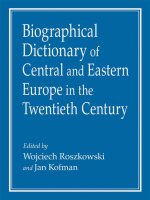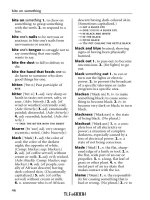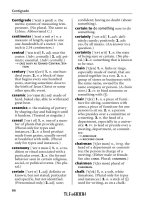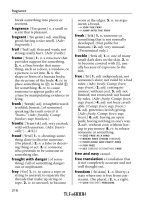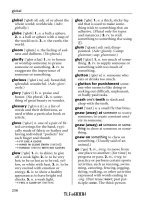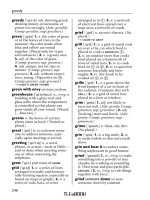Routledge dictionary of language and linguistics
Bạn đang xem bản rút gọn của tài liệu. Xem và tải ngay bản đầy đủ của tài liệu tại đây (6.98 MB, 1,335 trang )
Dictionary of Language and
Linguistics
Routledge Dictionary of Language
and Linguistics
Hadumod Bussmann
translated and edited by
Gregory Trauth and Kerstin Kazzazi
London and New York
The dictionary is based on: Hadumod Bussmann Lexikon der Sprachwissenschaft 2nd,
completely revised edition in co-operation with and with contributions by colleagues Kröner
Verlag, Stuttgart 1990. (Kröners Taschenausgabe, Vol. 452) ISBN 3-520-45202-2
Contributors to the German edition Gregorz Dogil, Bernd Gregor, Chistopher Habel, Theo Ickler,
Manfred Krifka, Hartmut Lauffer, Katrin Lindner, Peter R.Lutzeier, Susan Olsen, Beatrice Primus,
Hannes Scheutz, Wolfgang Sternefeld, Wolf Thümmel, Hans Uszoreit, Heinz Vater, Ulrich
Wandruszka, Dietmar Zaefferer
Translation and adaptation Lee Forester, Kerstin Kazzazi, Stephen Newton, Erin Thompson,
Gregory Trauth
First published 1996 by Routledge 11 New Fetter Lane, London EC4P 4EE
This edition published in the Taylor & Francis e-Library, 2006.
“To purchase your own copy of this or any of Taylor & Francis
or Routledge’s collection of thousands of eBooks please go to
www.eBookstore.tandf.co.uk.”
Simultaneously published in the USA and Canada by Routledge 29 West 35th Street, New York,
NY 10001
First published in paperback 1998
© 1996 Routledge
All rights reserved. No part of this book may be reprinted or reproduced or utilised in any form or
by any electronic, mechanical, or other means, now known or hereafter invented, including
photocopying and recording, or in any information storage or retrieval system, without permission
in writing from the publishers.
British Library Cataloguing in Publication Data A catalogue record for this book is available from
the British Library
Library of Congress Cataloging in Publication Data A catalog record for this book is available
from the Library of Congress
ISBN 0-203-98005-0 Master e-book ISBN
ISBN 0-415-02225-8 (hbk)
ISBN 0-415-20319-8 (pbk)
Contents
Preface
vi
Directory of participants
ix
User instructions
xvi
List of symbols used in the book
xviii
International Phonetic Alphabet
xxi
List of abbreviations in the text
xxiii
List of abbreviations in the bibliographies
xxvi
Entries
1-1034
Preface
Twenty-five years ago, when the idea for this dictionary was first conceived, researchers
of linguistics had virtually no terminological reference works that could provide them
with an introduction to this fast-growing international science or with source material for
conducting their own linguistic research. This situation has changed greatly over the
years, especially in the English-speaking world, where David Crystal’s Cambridge
Encyclopedia of Language and Frederick J.Newmeyer’s Cambridge Survey of Linguistics
were published in 1987. They were followed, in 1992 and 1994 respectively, by two
impressive encyclopedic works, namely W.Bright’s four-volume International
Encyclopedia of Linguistics (Oxford University Press) and R.E.Asher’s ten-volume
Encyclopedia of Language and Linguistics (Pergamon Press).
About the development of this dictionary
The present dictionary differs fundamentally from these monumental works. In its scope
and format, it fills a gap which, in spite of David Crystal’s Dictionary of Linguistics and
Phonetics (Oxford 19852), has existed up until now: in a handy one-volume format, this
dictionary provides a thorough overview of all areas of linguistics. Not restricted to
specific theories, it encompasses descriptive and historical, comparative and typological
linguistics, as well as the applied subdisciplines. Along with the traditional core areas
(phonology, morphology, syntax, semantics and pragmatics), interdisciplinary fields
(such as sociolinguistics, psycholinguistics, neurolinguistics and ethnolinguistics), as well
as stylistics, rhetoric and philosophy of language are represented. In addition, the
dictionary includes basic terminology from logic, mathematical and computational
linguistics as well as applied linguistics; finally, descriptions of individual languages and
language families are provided. With this broad range of content and its succinctly
written articles, this dictionary is meant for both students and professional scholars in
linguistics and allied fields.
This book is the result of over twenty years of development, in which numerous
scholars from Germany and other countries were involved. The first German edition
appeared in 1983 as the result of this author’s ten-year efforts. Owing to the rapid
development of linguistics, a second, completely revised edition became necessary.
Seventeen scholars revised, corrected and extended the texts of the first edition. Their
work was based on dozens of peer reviews and, no less importantly, on their own
research. This second German edition provided the foundation for the present English
edition, which was developed further by a team of translators along with numerous
contributors and advisers, who checked the translation, made additions to the texts and
bibliographies, and, in some cases, contributed new articles. In adapting the German
edition, the difference in terminological usage and methodological approaches of
Continental European linguists and of their British and North American colleagues
became apparent. The task of ‘translating’ became, therefore, not a linear word-for-word
rendering of German linguistic concepts into English, but rather an adaptation, in which
terminology specific to German linguistics was eliminated and articles dealing with
terminology specific to English were added. This adaptation is most apparent in the
linguistic examples that illustrate many of the concepts and that were provided by the
translators. contributors. and editors alike.
Contributors
Initially a one-woman project, the present dictionary is the collective work of some
seventy European and North American linguists. The authors of the second German
edition in many cases undertook revisions of their own work for this English edition.
Since even the best linguists can never hope to become experts in all of the subdisciplines
of linguistics, the American translators enlisted the assistance of more than two dozen
North American linguists to review the translations and adaptation of the entries for
accuracy and readability. All well versed and highly competent in their respective fields,
the contributors to this English edition helped to adapt the translations by verifying the
content, providing English-language examples, and rounding out the entries with
additional bibliographical references. During the final revision of the manuscript, which
took place in Munich, a second group of competent advisers provided additional editorial
help with texts, bibliographies and the co-ordination of cross-references. Some of these
new contributors even wrote new articles to supplement the already existing articles in
their areas of specialization. Because so many people had a hand in developing, writing
and revising the entries, individual names are not listed at the end of the articles. The
author and editors accept responsibility for any errors. We are thankful for any
corrections, additions, and other suggestions with which careful readers care to provide
us.
The co-ordination of these complex stages of work was for many years the exclusive
domain of the translator and editor-in-chief, Gregory Trauth, who, in the face of
numerous obstacles, pushed hard for the completion of the translation with unremitting
patience and in constant close contact with the author. Over the years, both the author and
the editor undertook many journeys across the Atlantic; indeed, the number of faxes
dealing with the dictionary would probably reach across the ocean, too! Owing to
professional obligations, Gregory Trauth could not, however, see the project to its end;
the final version of the dictionary, therefore, was prepared in Munich by Kerstin Kazzazi.
A native speaker of German and English, she undertook this task with competence and
commitment in co-operation with the author, Hadumod Bussmann, and the Routledge
editorial staff. Her job consisted of making the complete text uniform and consistent in
style, revising content, translating a number of new articles, extending the system of
cross-references, updating the bibliographies and researching all of the etymological
notes from English sources.
Acknowledgements
The author and editors were the fortunate recipients of a great amount of support:
financial, scholarly, technical and moral. Many thanks are due to the Deutsche
Forschungsgemeinschaft, who for two years subsidized the preparation of the expanded
German edition, and to Inter Nationes, who sponsored the translation.
To mention the names of all the people who contributed to this book would exceed the
scope of this preface. Therefore, a list of participants and their contributions is appended
to the preface. I wish to thank specifically
all the German co-authors who checked, corrected and amended the adaptation of their
special areas of specialization (list 1);
the translators, critical readers and advisers, who, in different ways, contributed to the
task of bringing the text, which was originally addressed to a German-speaking
readership, into a form that meets Anglo-American expectations (list 2);
the assistants in Munich, who, in the very last stages, made bibliographical
emendations and/or gave (in some cases extensive) advice and made contributions in
their areas of specialization (incorporated into list 3);
the Routledge editorial staff, especially Jonathan Price, Wendy Morris, Alex Clark,
Sarah M.Hall, Samantha Parkinson, and Jenny Potts;
the editor-in-chief, Gregory Trauth, who over many years invested all of his spare time
in the dictionary, and who, with competence, circumspection and organizational talent,
co-ordinated the efforts of the translators and numerous contributors;
and, last but not least, the co-editor Kerstin Kazzazi, who set aside her own research
for the dictionary, and without whose perseverance, co-operative patience and pleasure in
the work the final goal of this book would never have been attained.
The motto of the German edition also applies to the present book:
Such a work is actually never finished, one must call it finished when,
after time and circumstances, one has done what one can.
(J.W.Goethe, Journey to Italy,
16 March 1787)
Hadumod Bussmann
Munich, August 1995
Directory of participants
1 Contributors to the (second) German edition of
the Lexikon der Sprachwissenschaft
Hadumod Bussmann
Dr. phil., Lecturer in Germanic Linguistics; University of Munich
Pertinent publications: Lexikon der Sprachwissenschaft, Stuttgart, 1983 (2nd revised
and completely updated version Stuttgart, 1990).—Das Genus, die Grammatik und—der
Mensch: Geschlechterdifferenz in der Sprachwissenschaft. In H.Bussmann and R.Hof
(eds), Genus: zur Geschlechterdifferenz in den Kulturwissenschaften, Stuttgart,1995.
114–60.
Areas: basic terminology, grammar, linguistic schools, psycholinguistics, syntax.
Grzegorz Dogil
Professor of Experimental Phonetics; Institute of Computational Linguistics,
University of Stuttgart
Pertin
ent publication:
Autosegmental account of phonological emphasis, Edmonton,
1979.
Area: phonology.
Bernd Gregor
Dr. phil., MBA, Vice President Interactive Services, Bertelsmann Distribution GmbH
Pertinent publication: Computerfibel für Geisteswissenschaftler, ed. B.Gregor and
M.Krifka, Munich, 1986.
Area: computational linguistics.
Christopher Habel
Professor of Computer Science (Knowledge and Language Processing
);
University of Hamburg
Pertinent publications: Prinzipien der Referentialität, Berlin, 1986.—Stories: an
artificial intelligence perspective. Poetics (1986), 15.111–25.
Area: artificial intelligence.
Theodor Ickler
Professor of German Linguistics and German as a Foreign Language;
University of Erlangen-Nuremberg
Pertinent publications: Deutsch als Fremdsprache: eine Einführung in das Studium,
Tübingen, 1984.—Die Disziplinierung der Sprache, Tübingen, 1996. Various articles on
linguistics, language pedagogy, and language for special purposes.
Areas: applied linguistics, second-language acquisition. (Also worked on the English
edition with revisions and additions.)
Manfred Krifka
Associate Professor of Linguistics; University of Texas, Austin
Pertinent publications: Zur semantischen und pragmatischen Motivation syntaktischer
Regularitäten: eine Studie zu Wortstellung und Wortstellungsveränderung im Swahili,
Munich, 1983.—Thematic relations as links between nominal reference and temporal
constitution. In I.Sag and A.Szabolcsi (eds), Lexical Matters, Chicago, 1992.
Areas: non-European languages, typology of languages.
Hartmut Lauffer
Dr. phil., Lecturer in Germanic Linguistics; University of Munich
Areas: rhetoric, stylistics, text linguistics. (Also worked on the English edition with
revisions, and additions.)
Katrin Lindner
Dr. phil., Lecturer in German Linguistics; University of Munich
Pertinent publications: Sprachliches Handeln bei Vorschulkindern, Tübingen, 1983.—
Various articles about German-learning children with specific language impairment.
Areas: conversational analysis, discourse analysis, neurolinguistics, psycholinguistics.
(Also worked on the English edition with translations, revisions, and additions.)
Peter Rolf Lutzeier
Chair in German; University of Surrey, Guildford, UK
Pertinent publications: Modelltheorie für Linguisten, Tübingen, 1973.—Wort und
Feld, Tübingen, 1981.—Linguistische Semantik, Stuttgart, 1985.—Major pillars of
German syntax, Tübingen, 1991 (ed.)—Studies in Lexical Field Theory, Tübingen,
1993.—Lexikologie. Tübingen, 1995.
Areas: semantics, logic. (Also worked on the English edition with revisions and
additions.)
Susan Olsen
Professor of German Linguistics; University of Stuttgart
Pertinent publications: Wortbildung im Deutschen, Stuttgart, 1986.—Various articles
on word formation.
Areas: morphology, word formation. (Also worked on the English edition with
revisions and additions.)
Beatrice Primus
Dr. habil., Lecturer in German and Theoretical Linguistics; University of Munich
Pertinent publications: Grammatische Hierarchien, München, 1987.—Syntactic
relations. In J.Jacobs et al. (eds), Syntax: an international handbook, Berlin, 1993. 686–
705. Word order and information structure. In J.Jacobs et al. (eds), 880–96.
Area: syntax (particularly, articles on aspect, diatheses, case, syntactic functions,
models, markedness theory, relational typology, theme vs. rheme, word order). (Also
worked on the English edition with revisions and additions.)
Hannes Scheutz
Dr. phil., Lecturer in German Linguistics; University of Salzburg
Pertinent publication: Strukturen der Lautveränderung, Vienna, 1985.
Areas: dialectology, language change, sociolinguistics. (Also worked on the English,
edition with revisions and additions.)
Wolfgang Sternefeld
Associate Professor of Linguistics; University of Tübingen
Pertinent publications: (In co-operation with A.von Stechow): Bausteine syntaktischen
Wissens: ein Lehrbuch der generativen Grammatik, Opladen, 1988.—Syntaktische
Grenzen: Chomskys Barrierentheorie und ihre Weiterentwicklungen. Opladen, 1991.—
(In co-operation with G.Müller): Improper movement and unambiguous binding.
Linguistic Inquiry 24 (1993), 461–507.
Area: generative/transformational grammar. (Also worked on the English edition with
revisions and additions.)
Wolf Thümmel
Professor of Linguistics; University of Osnabrück
Areas: phonetics, graphemics, Slavic languages. (Also worked on the English edition
with revisions and additions.)
Hans Uszkoreit
Professor of Computational Linguistics; University of Saarbrücken
Pertinent publications: Word Order and Constituent Structure in German. (CSLI
Lecture Notes 8.) Stanford, CA. 1986.—From feature bundles to abstract data types: new
directions in the representation and processing of linguistic knowledge. In A.Blaser (ed.),
Natural Language on the Computer, Berlin, 1988.
Area: Unification Grammar.
Heinz Vater
Professor of Germanic Linguistics; University of Cologne
Pertinent publications: Das System der Artikelformen im gegenwärtigen Deutsch, 2nd
edn, Tübingen, 1979.—Dänische Subjekt-und Objektsätze, Tübingen, 1973.—Einführung
in die Raumlinguistik, 2nd edn, Hürth, 1991.—Einführung in die Zeitlinguistik, 3rd edn,
Hürth, 1994.—Einführung in die Textlinguistik, 2nd edn, Munich, 1994.
Area: reference semantics. (Also worked on the English edition with revisions and
additions.)
Ulrich Wandruszka
Professor of Romance Linguistics; University of Klag
enfurt
Pertinent publications: Probleme der neufranzösischen Wortbildung, Tübingen, 1976.
Studien zur italienischen Wortstellung, Tübingen, 1982.—(With O.Gsell.) Der
romanische Konjunktiv, Tübingen, 1986.—“Klassemisch” versus “Lexemisch”: zwei
Grundtypen sprachlicher Strukturbildung. PzL 41 (1989), 77–100.—Zur Suffixpräferenz:
Prolegomena zu einer Theorie der morphologischen Abgeschlossenheit. PzL 46 (1992),
3–27.
Area: Romance languages. (Also worked on the English edition with revisions and
additions.)
Dietmar Zaefferer
Associate Professor of German and Theoretical Linguistics; University of Munich
Pertinent publications: The semantics of non/declaratives: investigating German
exclamatories. In R.Bäuerle et al. (eds), Meaning, Use, and Interpretation of Language,
Berlin, 1983. 466–80.—Frageausdrücke und Fragen im Deutschen: zu ihrer Syntax,
Semantik und Pragmatik, Munich, 1984.—On the coding of sentential modality. In
J.Bechert et al. (eds), Toward a Typology of European Languages, Berlin, 1990. 215–37.
Areas: pragmatics, discourse semantics. (Also worked on the English edition with
revisions and additions.)
2 Editors, contributors, translators, critical readers
and advisers of the English text
Hersilia Alvarez-Ruf, Ph.D.
Professor of Spanish Languages; Hope College, Holland, MI
Critical reader of Romance languages
Helga Bister-Broosen, Ph.D.
Professor of German; University of North Carolina
Consultant for sociolinguistics
Mary Bosker
Bibliographical research
William A.Corsaro, Ph.D.
Professor of Sociology; Indiana University, Bloomington
Critical reader and adviser for conversational analysis
Lee Forester, Ph.D.
Professor of German; Hope College, Holland, MI
Translator: basic terminology, grammar, languages, syntax, typology of languages
Judith R.Johnston, Ph.D.
Professor and Director: School of Audiology and Speech Sciences, University of
Columbia, Vancouver, BC, Canada
Critical reader and adviser for neurolinguistics
Kerstin Kazzazi, MA
Indo-European Studies, English; Munich
Editor, translator, contributor of articles, bibliographical research
Tracy Holloway King, Ph.D.
Visiting Research Associate
Linguistics Department, Indiana University, Bloomington
Critical reader and adviser for generative/transformational grammar
Paul Listen, MA
Bibliographical research
John Nerbonne
Professor of Computational Linguistics; Rijksuniversiteit Groningen
Critical reader, contributor and adviser for mathematical and computational linguistics
Stephen Newton, Ph.D.
Lecturer of German; University of California, Berkeley
Assistant editor and translator: basic terminology, Bay Area Grammar, generative/
transformational grammar, rhetoric and stylistics, text linguistics, Unification Grammar
Timothy Radzykewycz, MA
Critical reader and adviser for phonetics, phonology
Lyon Rathbun, Ph.D.
Critical reader and adviser for rhetoric, stylistics
William Reynolds, Ph.D.
Professor of English; Mesa State College, Grand Junction, CO
Consultant for English
Tom Shannon, Ph.D.
Professor of Germanic Linguistics; University of California, Berkeley
Critical reader and adviser for grammar, syntax
H.Jay Siskin, Ph.D.
Lecturer of French; Brandeis University
Critical reader and adviser for applied linguistics, psycholinguistics
Tiffany Stephens
Bibliographical research
Talbot J.Taylor, Ph.D.
Professor of Linguistics; College of William and Mary, Williamsburg, VA
Critical reader for linguistic schools
Erin Thompson, BA
Translator: linguistic schools, phonetics, phonology
Michael Toolan, Ph.D.
Professor of English; University of Washington, Seattle
Critical reader for pragmatics
Gregory Trauth, Ph.D.
Editor-in-chief and translator: applied linguistics, artificial intelligence, computational
linguistics, conversational analysis, discourse analysis, graphemics, language change,
logic, morphology, neurolinguistics, phonetics, phonology, pragmatics, psycholinguistics,
second-language acquisition, semantics, sociolinguistics
Erwin Tschirner, Ph.D.
Professor of German; University of Iowa
Consultant for applied linguistics, second language acquisition
Ann Von Pohl, Ph.D.
Editorial assistant
Roland Willemyns
Universitet Brugge
Consultant for sociolinguistics
Adger Williams, Ph.D.
Critical reader for Slavic languages
Kirsten Windfuhr
Editorial assistant, bibliographical research
3 Colleagues who at different times and stages of
the project and to a different extent assisted and
contributed to the German and/or English edition
Karin Böhme-Dürr, Penny Boyes Braem, Vit Bubenik, Paola Cotticelli-Kurras, Rita
Fejér, Helene Feulner, Winfried Fiedler, Hans Fromm, Monica Genesin, J.Th.M.Giesen,
Heike Gläser, Wolfgang Hock, Joachim Jacobs, Corinna Jäger, MirKamaleddin Kazzazi,
Suzanne
Ulrich J.Lüders, Imke Mendoza, Peter-Arnold Mumm, Jochen Range, Marga Reis, Elke
Ronneberger-Sibold, Wolfgang Schulze, Ariane von Seefranz, Klaus Strunk, Renate
Syed, H.G.Wallbott, Stefan Weninger, Nora Wiedenmann.
User instructions
Basic structure of the entries
The individual entries are based on the following structure:
The square brackets immediately after the bold headword contain the following
information:
(a)Abbreviations used in linguistics for the respective term, e.g. IPA for International
Phonetic Alphabet
(b)Etymological remarks on loanwords. These are not to be understood as exact
philological derivations; rather, they are meant to aid intuitive understanding of the
formation of the respective term and are of mnemotechnical value. If several
headwords are based on the same loanword, only the first receives the etymological
remarks, e.g. Greek hómos ‘same’ for homogenetic, homography, homonymy,
homophony, etc.
Defining/explanatory text: different usages of a term are designated by 1, 2, 3; different
aspects of description or structure of a certain usage are marked by (a), (b), (c) or (i), (ii),
(iii); see e.g. transformational grammar and language change.
Bibliographical material
All references within the text of the entries are cited below the entry. In order to avoid too
much repetition, some entries do not have any references, but instead a cross-reference to
more general entries with comprehensive bibliographies.
The bibliographies of central entries are structured into sections for general texts,
bibliographies, and journals; in some, language articles, grammars, and dictionaries are
also listed separately.
Within the individual groups, the titles are listed in alphabetical order.
The date in parentheses after the name is usually the date of first publication, with
later editions following at the end of the reference.
Abbreviations and symbols
All rarely used abbreviations that are to be found in the text or in linguistic literature are
listed on p. xxi.
The list of symbols (p. xvii)—structured according to the areas linguistics, logic, and
set theory—provides an overview of all symbols used in the text, as well as alternative
symbolic conventions, examples and cross-references to the respective entries in which
these symbols are explained or used.
The abbreviations for journals used in the bibliographies are based mainly on the
practice of the Bibliographie linguistique.
Phonetic transcription
The phonetic-phonological transcriptions of the examples are generally based on the
International Phonetic Alphabet (IPA), as given on p. xix. Depending on the context, a
‘narrower’ or ‘broader’ transcription is used (
phonetic transcription). Historical
examples are usually—if a more exact phonetic-phonological differentiation is not
required—given in the (quasi-orthographical) way commonly used in historical
grammars (e.g. Old High German consonant shift).
List of symbols used in the book
Linguistics
‹…› pointed brackets for orthographical representation, e.g. ‹top›
[…] square brackets for:
1
phonetic transcription, e.g.
.
2
features, e.g. [+nasal]
3
domination (relation), e.g. [art+NP]NP ‘NP dominates Art+N’ (
4 philological remarks on the headword
tree diagram)
/…/ slashes for phonological transcription
{…} curly brackets for:
morphemes, e.g. {s} for the plural in nouns
1
2 alternative rule application (
bracketing)
3 gathering of elements of a set, e.g. S={singular, plural, dual}
(…) parentheses for optional elements, e.g. NP→ART+(ADJ)+N
/ alternative expressions: come here/soon/again
+ plus sign for:
1 word formation or morpheme boundaries, e.g. bed+room
2 sign for concatenation of elements, e.g. S→NP+VP
3 positive specifications in features, e.g. [+nasal]
: colon for:
1 length in vowels, e.g. [a:]
2 designation of oppositions, e.g. [voiced]: [voiceless]
* asterisk for:
1 an ungrammatical, inacceptable expression, e.g. *she sleep
2 a reconstructed, undocumented form, e.g. IE *ghabh-, IE root of Eng. give.
→ simple arrow:
1 ‘expression is decomposed into…’ (
2 ‘implies’ (
implication)
phrase structure rules)
double arrow:
1 ‘expression is transformed into…’ (
transformation)
2 cross-reference to other entry in the dictionary, e.g.
linguistics
> pointed bracket to the right:
1 ‘becomes’, e.g. West Gmc *drankjan>Eng. drench (
2 ‘greater than’
umlaut)
< pointed bracket to the left:
1 ‘comes from’, e.g. Eng. drench
umlaut)
# boundary symbol, e.g. # sentence #
Logic
Sign Alternative sign Designation
To be read as
Explanation
notation
Λ
&
conjunction
‘and’
conjunction (3)
disjunction
‘or’
disjunction
material
implication
‘if, then’
implication (a)
equivalence
‘exactly if, then’
equivalence
~, –
negation
‘not’
negation (1)
╞
logical/strict
implication
‘from…follows’
implication (b),
(c)
, (E…)
existential
operator
‘there is at least one element x,
for which it is the case…’
operator (a)
(…)
universal operator ‘for all x it is the case that’
operator (b)
iota operator
‘that element x, for which it is
the case that’
operator (c)
lambda operator
‘those xs, for which it is the
case that’
operator (d)
→
↔
¬
ι
,≡
i
λ
□
under
N
necessity operator ‘it is necessary that’
implication (c)
P
possibility
operator
modal logic
‘it is possible that’
Set theory
Sign
Designation
To be read as
Explanation
under
{a1,
a2}
combination of the elements a1, a2 to a
set S
Ø
empty set
set
‘empty set’
set
ε
element relation
‘is an element of’
set (b)
‘is not an element of’
∩
intersection set
‘intersects with’
set (h)
\
difference set
‘minus’
set (i)
subset
‘is contained in’
set (j)
complement set
‘is complement of’
set (k)
union set
‘united with’
set (g)
P
power set
‘set of all subsets’
set (l)
X
Cartesian product
‘set of all ordered pairs’
set (n)
Card
cardinal number
‘number of elements in a
set’
cardinal number
C
The International Phonetic Alphabet
List of abbreviations in the text
AD
after Christ (Anno Domini)
BC
before Christ
ca
circa
cf.
1. compare
2. see (Author name+year)
e.g.
for example
etc.
etcetera
i.e.
that is
mil.
million
vs.
versus
Amer.
American
Brit.
British
Bulg.
Bulgarian
Dan.
Danish
Eng.
English
Fr.
French
Ger.
German
Gmc.
Germanic
Grk
Greek
Heb.
Hebrew
IE
Indo-European
Ital.
Italian
Lat.
Latin
ME
Middle English
MFr.
Middle French
MHG
Middle High German
OCSlav
Old Church Slavic
OE
Old English
OFr.
Old French
OHG
Old High German
OInd.
Old Indic
PGmc.
Proto-Germanic
PIE
Proto-Indo-European
Rum.
Rumanian
Russ.
Russian
Serb.
Serbo-Croatian
Skt
Sanskrit
Slav.
Slavic
Span.
Spanish
Swed.
Swedish
1. pers.
1st person
2. pers.
2nd person
3. pers.
3rd person
abl.
ablative
acc.
accusative
Adj.
adjective
Adv.
adverb
approx.
approximately
Aux.
auxiliary
C
consonant
dat.
dative
DO
direct object
fem.
feminine
fut.
future
gen.
genitive
indic.
indicative
ins.
instrumental
IO
indirect object
irreg.
irregular
loc.
locative
masc.
masculine
N, NP
noun, noun phrase
neut.
neuter
nom.
nominative
O
object
Part.
participle
perf.
perfect
pl.
plural




